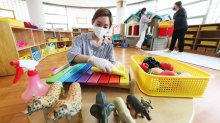Teachers Around the World Tell Us Reopening Is Tough, but Joyful
In countries where infection rates have stabilized, schools are reopening. When we asked how that’s going, over 600 teachers responded.
It was Dr. Anthony Fauci who pushed back, in the early days of the pandemic, on the understandable desire for timelines: “You don’t make the timeline, the virus makes the timeline,” he noted tersely, in response to a reporter’s question. The implications of that simple statement have become clearer as the crisis drags on, with no definitive end in sight.
But if there are still plenty of unknowns, there’s also a pattern of forward momentum as countries around the world—and more to the point, various communities within those countries—begin to open the doors to their businesses, schools, and other institutions. One dictum has given way to the next: Just a few days ago, Fauci appeared to endorse school openings in the U.S. in the fall, particularly as the viral activity in some areas decreases. “In some situations there will be no problem for children to go back to school,” said Fauci. “In others, you may need to do some modifications.” Schools in rural Montana may look nothing like schools in New York City in the fall, in other words, and it wouldn't be surprising to see some physical schools closed as the traditional school year starts.
To get a sense of what the new normal looks like across the world, we read global news reports and then reached out on social media to teachers who are back in school. We received a torrent of responses: More than 600 teachers from over 50 countries joined the conversation, with many leaving detailed descriptions of their schools' reopening policies. We followed up with email and Facebook interviews with 20 of those teachers, generating about 50 pages of further documentation.
Here’s our synthesis of the responses we received from educators worldwide—we hope it helps.
The Big Picture—Things Are Going Well
While more than a few educators told us that they worry about new outbreaks, a clear majority of teachers reported they are happy to be back in school—and so are the students.
Despite all the new rules and restrictions, younger students “get out of cars or off the bus in the morning with gigantic smiles” and are delighted to see friends and teachers, said Laura Landers, a primary school leader in the Netherlands. In China, high school biology teacher Christopher Noordhoek’s students “were really struggling with anxiety and depression during the height of the pandemic.” The return to school has “not only brought them a sense of normalcy and routine but also a network of friends and teachers to keep each other grounded.”
The return to school has been far from perfect. Teachers reported that it has left them “exhausted” and anxious, and the learning curve for remote teaching remains steep. Some felt like they had been asked to come back too early. Still, most of our respondents agreed that kids were learning effectively in classrooms, that the return to school was a good idea, and even that technology integration, while challenging, was improving pedagogy around the world.
Alternate Day Attendance Is the New Normal
The complicated logistics of social distancing—the choreographing of arrivals and exits, in-school transitions, and seating arrangements, for example—tend to break down when there are too many bodies in motion. Kids crowd each other as they line up to exit a classroom or get their temperatures checked, admitted several teachers. Younger children forget rules quickly. In Auckland, New Zealand, high school teacher Constance McCombe told us that social distancing is “an impossible task for teenage girls. They get close, they touch, they hug.”
Being realistic about the limitations of rules and protocols is crucial, then, and in our interviews it was clear that many schools around the world—in Greece, the Netherlands, Germany, Singapore, Canada, and Cyprus, among others—have addressed the overcrowding at the root of the problem by splitting classes in half and going to an alternate day schedule.
In the Netherlands, explains primary school leader Laura Landers, echoing an approach that has been adopted around the globe, “half the class attends school in person on Mondays and Tuesdays, while the other half does distance learning from home. Then we swap.” On Wednesdays all students learn remotely, the building is deep cleaned, high-needs students receive more individual attention, and educators plan lessons and hold crucial meetings to address emerging issues and kinks in the system.

There are some variants on the alternate day theme. Some schools, for example, tried splitting the student population into morning and afternoon sessions, but we suspect that’s a more complicated solution—and Landers agreed. In Singapore, an employee at the Ministry of Education reported that the student groups attend class on alternate weeks. And in Australia, at least initially, some schools initially brought individual grades back for only one day of the week.
No Matter What You Do, You’ll Need Good Technology
There appears to be no clear path to reopening without some form of online learning. A bewildering array of factors globally forced the issue.
In Canada, a staffer who works with students with special needs reported that medically fragile students were staying home and required online support. In the Netherlands, wrote primary school teacher Erin Comaskey—there were similar stories from countries like New Zealand, Germany, and Israel—“approximately 50 percent of families chose to continue with distance learning instead of returning to campus” when schools opened back up. Vulnerable teachers in several countries said they stayed home and taught via Zoom to a classroom monitored by another staff member. In a school in China, a handful of educators resorted to distance teaching when they were trapped on the other side of the country’s closed borders.
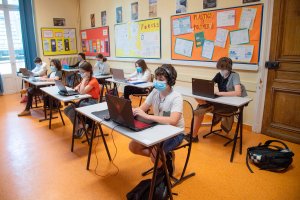
But that’s only part of the story. Staff meetings are held online to protect vulnerable members of the community, and school assemblies often occur as synchronous broadcasts to classrooms across the building. Flipped classrooms and blended approaches are emerging as new, durable models around the world. In Greece, writes secondary school teacher Erato Kostopoulou, in a burst of excitement, “we even tried an online debate tournament in which we competed with a local school in Thessaloniki, and it worked very well!”
Perhaps most importantly, a strong technology foundation can provide flexibility and continuity if the virus re-emerges and postpones reopenings or forces another round of school closures—as it has already in France, Israel, and South Korea—or when, as we heard from China, remediation or extended hours are needed to make up for significant learning loss among students.
Watch for a Special Case of Teacher Burnout
It’s tempting to think of the new teaching paradigm as short-term, and of solutions as mere Band-Aids to get you to the next phase of reopening—but that appears to be a recipe for early teacher burnout.
Worldwide, educators who responded to our questions reported that they were struggling to manage both distance and in-person learning simultaneously. The “face-to-face teaching hasn’t changed,” according to Charlotte Holmes, a teacher near Adelaide, Australia, but “we have had added teaching to do in the form of online content. As to be expected, this has increased our workload.” If a hybrid model is to work well for any period of time, close attention to this issue appears to be vital—and models that recognize and seek to reduce the workload for teachers are likely to be much more successful.
What can be done? In Luxembourg, middle school teacher Emily Lewis Agraz says that she uploads virtual lessons on Monday for the week, and then holds virtual and in-person class for all students at the same time. Virtual breakout rooms allow for grouping across the divide, but they’re imperfect—a “far cry from the normally dynamic, interactive lessons many teachers plan.” Secondary school teacher Michelle Kaszuba from Frankfurt, Germany, takes a similar tack: Some lessons allow for a “hybrid learning situation where you are engaging the entire class in both realms,” she writes, “while for others it might be best to work directly with the kids in the room, while those at home are working independently—and then they will flip tasks the next day.”
Not far away, in the Netherlands, school leader Laura Landers says that assigning a greater proportion of independent work is a key, since “teachers are busy in the classroom and cannot do as much online support.”
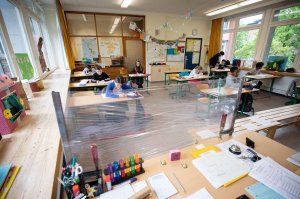
She also implemented an all-hands-on-deck policy, pulling in staff who are not classroom teachers to lend a hand with distance learning. Other leaders have temporarily reassigned faculty members from larger classes that cannot yet meet, like band, chorus, and theater.
Yes, the Play Goes On
Teachers (and parents) are especially worried about kids losing outdoor playtime. “I would not want my young child sitting at a desk all day, no recess, lunchroom break, or moving classrooms,” posted New York high school teacher Leah Dyan on Facebook—and more than 500 members of our audience expressed agreement. “That would be terrible for children.”
But teachers told us that play continues during the pandemic. In Busan, South Korea, for example, where classrooms are back to full capacity following a six-week shutdown, kids have playtime at their desks for now and do solo activities like origami or classroom games. For young kids, of course, that’s unlikely to suffice for long.
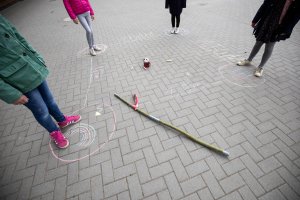
And there’s better news, too. In our review of comments and in our interviews, we found that outdoor recess remains an integral part of the school day in countries from Germany to New Zealand, Canada and the Netherlands—even as adults enforce playground rules around social distancing and post-recess hygiene.
Monkey bars, slides, and other playground equipment are still in use, though the structures are frequently cleaned, writes Jodi Hirsch, a kindergarten teacher in Israel. Games that involve tossing balls back and forth or frequent touching, like the game of tag, are discouraged. Already, teachers report, kids have invented an alternative in which the shadows of their peers are tagged as the game progresses.
Other rules that appeared frequently across the globe: staggered times for recess to eliminate congestion, and designating areas of the playground for each class to discourage unnecessary mixing of groups.
Still In Motion at Some High Schools (and Middle Schools)
While a CDC report on school reopening did advise that schools “restrict hallway use through homeroom stays or staggered release of classes,” there were not detailed guidelines for how that might work. The report did note that “not all strategies will be feasible for all schools” and that “limiting hall movement options can be particularly challenging in secondary schools.”
We found that middle and high school students in countries like China, Germany, New Zealand, and Luxembourg are, in fact, transitioning between classes—and while it involves a fair amount of preparation and staff oversight, teachers say it’s mostly manageable. “It’s a team effort,” says middle school principal Carol Wallace from Stavanger, Norway. “The one meter rule is by far the hardest for our middle and high school students to maintain. They need constant reminders.”
Around the world, hallways are taped off to keep kids in lanes; lockers are mostly off limits; arrows direct the flow of student traffic; and teachers are positioned at critical spots where kids tend to crowd or bump into each other. That last part can be challenging, according to Luxembourg’s Emily Lewis Agraz: “We also have to clean desks after each class, so the combination requires some smooth moves.”
Even on Health and Safety, Changing Protocols
There’s plenty of publicly available information on health and safety protocols in schools—from mask-wearing to testing for sickness and elevated temperatures. Unsurprisingly, we found that the rules and regulations were already shifting as communities around the globe entered new phases of the pandemic.
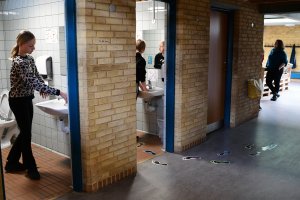
Frequent handwashing and cleaning of high-touch surfaces like door handles, desks, and classroom materials to mitigate viral spread remains the mainstay globally. In fact, we heard from some teachers that handwashing is such serious business, it’s included in their daily schedules, often between five and 10 times a day.
Our teachers expressed concern about wearing masks—many wondered if they could breathe effectively, and language teachers thought the masks would be a particular burden. “How do you communicate clearly to young children while teaching wearing a mask?” asked Jen Judson Grantham. “I hate that we cannot share smiles.” In many locations, masks were still required for both students and teachers—that’s the CDC recommendation as well, though they hint at exceptions for students—but masks are no longer frequently worn in countries like Australia, Norway, and New Zealand, for example, and even in China, where the virus first struck, a decline in cases has meant a relaxation of the standards around mask-wearing.
